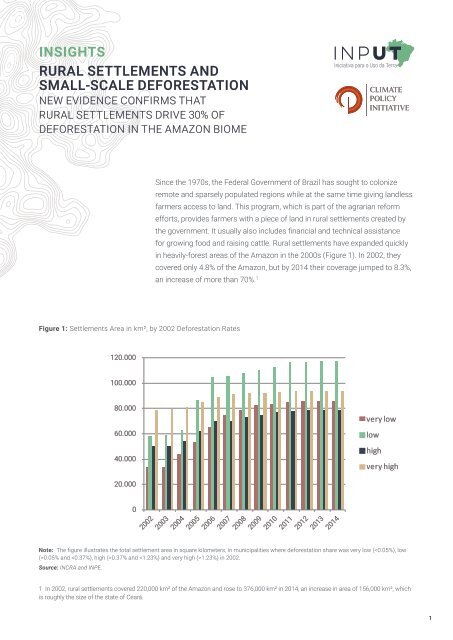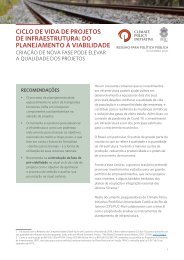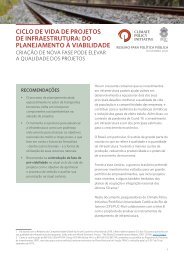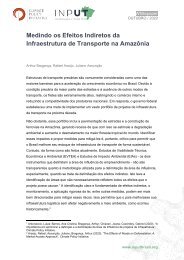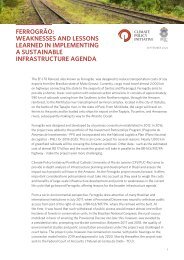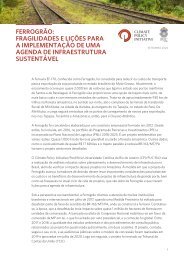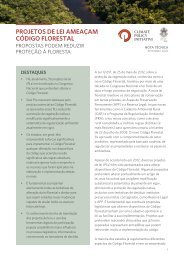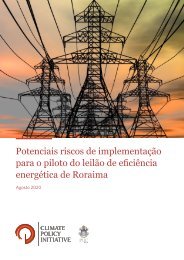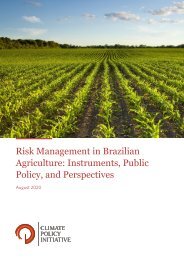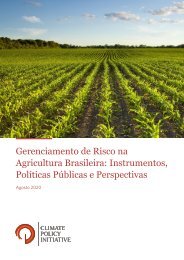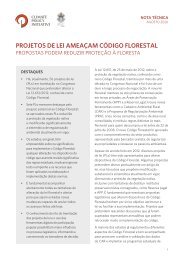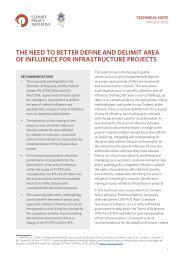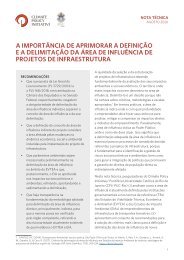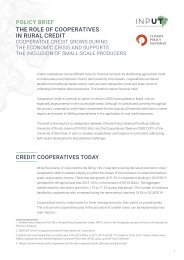Rural_Settlements_and_Small_Scale_Deforestation_Brief_EN_FINAL
You also want an ePaper? Increase the reach of your titles
YUMPU automatically turns print PDFs into web optimized ePapers that Google loves.
INSIGHTS<br />
RURAL SETTLEM<strong>EN</strong>TS AND<br />
SMALL-SCALE DEFORESTATION<br />
NEW EVID<strong>EN</strong>CE CONFIRMS THAT<br />
RURAL SETTLEM<strong>EN</strong>TS DRIVE 30% OF<br />
DEFORESTATION IN THE AMAZON BIOME<br />
Since the 1970s, the Federal Government of Brazil has sought to colonize<br />
remote <strong>and</strong> sparsely populated regions while at the same time giving l<strong>and</strong>less<br />
farmers access to l<strong>and</strong>. This program, which is part of the agrarian reform<br />
efforts, provides farmers with a piece of l<strong>and</strong> in rural settlements created by<br />
the government. It usually also includes financial <strong>and</strong> technical assistance<br />
for growing food <strong>and</strong> raising cattle. <strong>Rural</strong> settlements have exp<strong>and</strong>ed quickly<br />
in heavily-forest areas of the Amazon in the 2000s (Figure 1). In 2002, they<br />
covered only 4.8% of the Amazon, but by 2014 their coverage jumped to 8.3%,<br />
an increase of more than 70%. 1<br />
1 In 2002, <strong>Rural</strong> <strong>Settlements</strong> covered 220,000 km2 of the Amazon <strong>and</strong> rose to 376,000km2 in<br />
2014, an increase in area of 156,000 km2, which is roughly the size of the state of Ceará.<br />
Figure 1: <strong>Settlements</strong> Area in km², by 2002 <strong>Deforestation</strong> Rates<br />
120.000<br />
100.000<br />
80.000<br />
60.000<br />
40.000<br />
very low<br />
low<br />
high<br />
very high<br />
20.000<br />
0<br />
Note: The figure illustrates the total settlement area in square kilometers, in municipalities where deforestation share was very low (0.05% <strong>and</strong> 0.37% <strong>and</strong> 1.23%) in 2002.<br />
Source: INCRA <strong>and</strong> INPE.<br />
1 In 2002, rural settlements covered 220,000 km² of the Amazon <strong>and</strong> rose to 376,000 km² in 2014, an increase in area of 156,000 km², which<br />
is roughly the size of the state of Ceará.<br />
1
During this same time, Brazil slowed deforestation<br />
significantly. Conservation efforts reduced<br />
deforestation from 2004 to 2014 mainly by curbing<br />
large-scale clearings through a satellite-monitoring<br />
<strong>and</strong> enforcement system known as DETER. Because<br />
DETER could detect large clearings relatively<br />
easily, these clearings received better protection;<br />
deforestation fell by as much as 80% overall. But<br />
smaller clearings, which DETER has a harder time<br />
detecting, rose during this period in some areas. Thus,<br />
small-scale clearings emerged as the new frontier in<br />
the fight against deforestation. 2<br />
Given this new focus on smaller clearings, which<br />
rural farmers <strong>and</strong> ranchers often instigate, INPUT<br />
researchers at Climate Policy Initiative (CPI)/ PUC-Rio<br />
investigated a critical question: do rural settlements<br />
cause deforestation?<br />
Using a methodology based on econometric<br />
modelling, CPI found that rural settlements are<br />
responsible for 30% of deforestation in the Amazon<br />
2 www.inputbrasil.org<br />
UNIQUE FINDINGS ON RURAL<br />
SETTLEM<strong>EN</strong>TS AND DEFORESTATION<br />
region in 2014. Moreover, CPI found that special<br />
settlements, which are designed to support<br />
environmentally-friendly practices, lead to an<br />
especially large impact; they account for 15%, or half,<br />
of the total deforestation caused by rural settlements<br />
in the Amazon.<br />
These findings reinforce those identified in a<br />
separate 2016 study by the Amazon Environmental<br />
Research Institute (Instituto de Pesquisa Ambiental da<br />
Amazônia – IPAM). IPAM researchers, using a different<br />
methodology, also showed that rural settlements<br />
represented as much as 30% of the total Amazon<br />
forest area cleared in 2014. 3<br />
CPI’s research gives policymakers <strong>and</strong> stakeholders<br />
additional evidence for underst<strong>and</strong>ing the significant<br />
relationship between rural settlements <strong>and</strong><br />
deforestation. It also highlights the need for further<br />
investigation of the environmental role <strong>and</strong> impact of<br />
special settlements in the Amazon region.<br />
3 IPAM. (2016) Desmatamento nos Assentamentos da Amazônia<br />
Histórico, Tendências e Oportunidades available at http://ipam.<br />
org.br/wp-content/uploads/2016/02/Desmatamento-nos-<br />
Assentamentos-da-Amaz%C3%B4nia.pdf<br />
In order to estimate the impact of rural settlements<br />
on deforestation, it is important to account for<br />
deforestation that would have occurred in the Amazon<br />
area even if the settlements had not been established<br />
there. Moreover, the investigation needs to consider<br />
whether the settlers may have cleared forest outside –<br />
but still close to – the settlements, which is something<br />
that has not been done in previous research.<br />
CPI explored these questions by using a rigorous<br />
approach that allowed for the estimation of the impact<br />
of settlements on deforestation across the Amazon.<br />
CPI merged data on the area occupied by rural<br />
settlements, according to type of settlement, with data<br />
on municipality deforestation, which was obtained<br />
from satellite imagery. 4<br />
CPI concluded that rural<br />
settlements caused 30% of<br />
deforestation in the Amazon<br />
in 2014<br />
2 http://www.inputbrasil.org/wp-content/uploads/2015/11/Assuncao-et-al-WP2015-<strong>Deforestation</strong>-<strong>Scale</strong>-<strong>and</strong>-Farm-Size.pdf.<br />
3 IPAM (2016) Desmatamento nos Assentamentos da Amazônia. Histórico, Tendências e Oportunidades available at<br />
http://ipam.org.br/wp-content/uploads/2016/02/Desmatamento-nos-Assentamentos-da-Amaz%C3%B4nia.pdf.<br />
4 National Institute of Colonization <strong>and</strong> Agrarian Reform (INCRA) <strong>and</strong> National Institute for Space Research (INPE).<br />
2
They then calculated the share of municipal area<br />
covered by settlements <strong>and</strong> deforestation from 2002<br />
to 2014. CPI’s methods allow for isolating the impact<br />
of rural settlements on deforestation from that of<br />
other possible contributing factors. They found that<br />
the greater the share of settlement area within a<br />
municipality, the greater the share of cleared forest<br />
annually.<br />
Using this approach, CPI concluded that rural<br />
settlements caused 30% of deforestation in the<br />
Amazon in 2014. This takes into account the<br />
deforestation observed within rural settlements <strong>and</strong> in<br />
areas adjacent to the settlements. They confirm that<br />
a substantial amount of deforestation occurs in the<br />
Amazon because of the presence of rural settlements,<br />
<strong>and</strong> especially because of special settlements.<br />
UNDERSTANDING DEFORESTATION<br />
IMPACT BY SETTLEM<strong>EN</strong>T TYPE<br />
AND LOCATION<br />
To underst<strong>and</strong> better how rural settlements affect<br />
deforestation, CPI researchers examined the<br />
differences in deforestation depending on the location<br />
of the settlements <strong>and</strong> their type. Four types of<br />
settlements were considered: the colonization rural<br />
settlements (older settlements with no variation<br />
during the time period considered); conventional<br />
rural settlements (the more common ones); state<br />
<strong>and</strong> municipal rural settlements (created <strong>and</strong> mostly<br />
supported by states <strong>and</strong> municipalities – occupy a<br />
relatively small area); <strong>and</strong> special rural settlements<br />
(designed to promote more sustainable production<br />
techniques).<br />
The researchers identified an<br />
increase in deforestation in the<br />
special settlements, showing<br />
that these areas account for 15%,<br />
or half of the total deforestation<br />
by rural settlements, in the<br />
Amazon in 2014<br />
CPI shows that designating new, large tracts of l<strong>and</strong><br />
for rural settlements in rural forested areas causes a<br />
certain amount of deforestation due to human <strong>and</strong><br />
economic activity. This is true even if those activities<br />
aim to be environmentally-friendly, such as those<br />
that occur on special settlements. These special<br />
settlements are designed to serve farmers who wish<br />
to work with more sustainable production techniques,<br />
such as using fewer or no pesticides, or who want to<br />
work in more sustainable extractive activities, such as<br />
renewable forestry. The special settlements were often<br />
concentrated in areas with very high forest coverage<br />
<strong>and</strong> with almost no previously detected deforestation<br />
(Figure 2). To establish agricultural activities in such<br />
regions, even with sustainable practices, farmers<br />
need a tract of cleared l<strong>and</strong> to produce, <strong>and</strong> thus need<br />
to deforest, unless they are engaged exclusively in<br />
extractive activities. The researchers identified an<br />
increase in deforestation in these areas, showing that<br />
special settlements account for 15%, or half of the<br />
total deforestation by rural settlements, in the Amazon<br />
in 2014.<br />
3
Figure 2: Settlement Area in the Amazon<br />
Tree Cover<br />
Settlement<br />
Legal Amazon Border<br />
(a) Special <strong>Settlements</strong> 2002<br />
(b) Special <strong>Settlements</strong> 2011<br />
(c) Conventional <strong>Settlements</strong> 2002 (d) Conventional <strong>Settlements</strong> 2011<br />
Note: The figures illustrate the evolution of settlements by type in relation to the forest coverage in the legal Amazon between 2002 <strong>and</strong> 2011.<br />
Source: INCRA.<br />
Though deforestation also takes place in traditional<br />
rural settlements (conventional settlements <strong>and</strong> state<br />
<strong>and</strong> municipal rural settlements), the researchers<br />
show they are not the driving force behind it. The<br />
correlation that has been identified in the past<br />
between conventional settlements <strong>and</strong> deforestation<br />
seems to be motivated by the presence of factors<br />
that affect both deforestation <strong>and</strong> the creation of this<br />
type of rural settlements, such as location in areas of<br />
strong agriculture expansion.<br />
These findings emphasize the significant role that<br />
special settlements played in deforestation in<br />
the Amazon from 2002 to 2014. The study offers<br />
important insights on how other government policies<br />
affect small-scale deforestation <strong>and</strong> suggest a need to<br />
take a more holistic approach for targeting small-scale<br />
deforestation in Brazil.<br />
4
AUTHORS<br />
Juliano Assunção<br />
Climate Policy Initiative (CPI) & Núcleo de Avaliação<br />
de Políticas Climáticas da PUC-Rio (NAPC/PUC-Rio),<br />
Department of Economics, PUC-Rio<br />
juliano.assuncao@cpirio.org<br />
Romero Rocha<br />
Department of Economics, UFRJ<br />
romero.rocha80@gmail.com<br />
SOURCE<br />
“<strong>Rural</strong> <strong>Settlements</strong> <strong>and</strong> <strong>Deforestation</strong> in the<br />
Amazon” (Working Paper), 2016.<br />
Media Contact<br />
Mariana Campos<br />
mariana.campos@cpirio.org<br />
www.inputbrasil.org<br />
December 2016<br />
The L<strong>and</strong> Use Initiative (INPUT – Iniciativa para o Uso da Terra) is a dedicated team of specialists who work at the forefront of how to increase<br />
environmental protection <strong>and</strong> food production. INPUT engages stakeholders in Brazil’s public <strong>and</strong> private sectors <strong>and</strong> maps the challenges for a better<br />
management of its natural resources. Research conducted under INPUT is generously supported by the Children’s Investment Fund Foundation (CIFF)<br />
through a grant to the Climate Policy Initiative.<br />
5


